SOUTH BAY WATCH
SOUTH BAY CITIES COUNCIL OF GOVERNMENTS
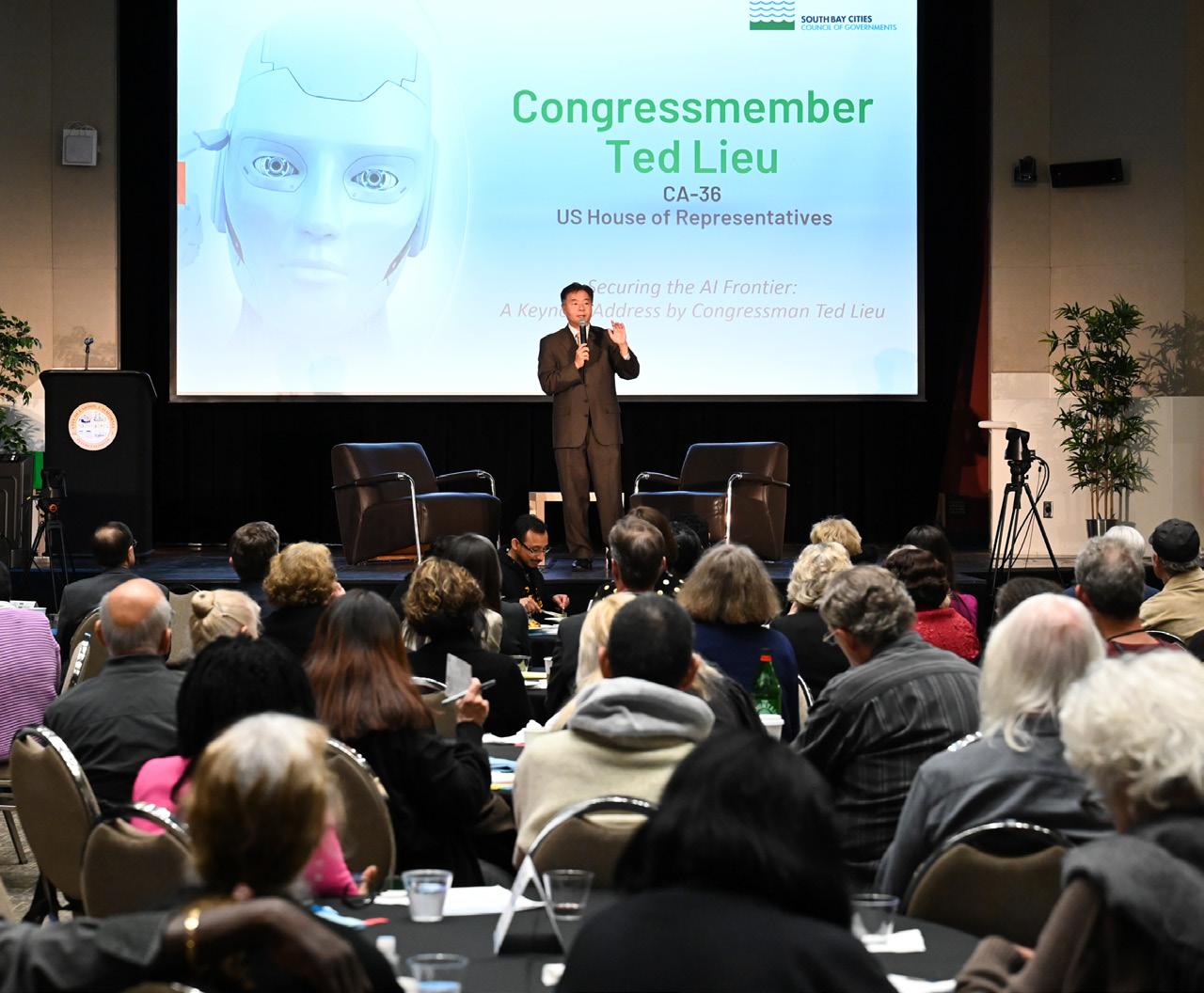
IN THIS


IN THIS
GENERAL ASSEMBLY RECAP SPEAKERS FORECAST IMPACTS OF ARTIFICIAL INTELLIGENCE ON THE WORKFORCE AND DELIVERY OF PUBLIC SERVICES
See Page 2
PAGE 4
The 24th General Assembly in Pictures
PAGE 5
“Sustainability in Action Photo Contest” Winners Demonstrate that Small Hands Make a Big Difference
PAGE 6 West Basin’s Water Recycling Plant Expansion in Carson Moves SoCal Closer to Water Self-Sufficiency
PAGE 7
Perspective: Los Angeles County is Leading the Effort to Advance Digital Equity
PAGE 8
Robust Senior Programs Prove that Age is Only a Number in Gardena
Prioritizing Vision Over Efficiency Will Make or Break Successful AI Use
The impact that artificial intelligence (AI) is expected to have on future local government hiring can be understood by examining the eventual outcome of the 1983 invention of Microsoft Word, according to Micah Gaudet, deputy city manager and chief public safety officer for Maricopa, Arizona.
“[Today] You could have the absolute best person for that job … the right culture fit; they’ve got a good work ethic; they’ve been working in the industry for a while; everything lines up perfectly. If they don’t know Microsoft Word, you’re not going to hire them, and in fact, you’re not even going to interview them,” Gaudet told the audience of more than 400 elected leaders, city staff and residents at the South Bay Cities Council of Governments’ 24th General Assembly. “That’s the reality and has been the reality for the past 10 to 20 years now in local government … AI is going to have a similar end result.”
Each year, the General Assembly brings thought leaders together to discuss important regional issues. This year’s event was themed Artificial Intelligence: Friend or Foe for the South Bay? Gaudet, who founded the AI and Local Government Network, which connects 200 members from 190 local governments worldwide, was among six
speakers to explore how AI could potentially benefit local governments, as well as potential red flags that cities should consider when adopting and using the technology.
In his talk titled “Steering Creativity and Efficiency: Driver’s Education for Generative AI,” Gaudet asserted that when integrating AI into city work, efficiency for efficiency’s sake isn’t always desirable. Instead, he encourages local government professionals to employ AI technologies to be efficient with the “right things.”
As an example of “wrong” things, he recapped the tale of film company Kodak’s demise. While Kodak invented digital camera technology, it failed to see where the industry was going and focused on efficiency over vision, putting “all their chips in physical media.” This led to the company’s eventual bankruptcy.
“AI is an accelerator. An accelerator is very, very helpful when you’re moving in the right direction on the highway. If you’re going the wrong direction, it’s downright deadly,” he said. To avoid steering off course, he recommends that organizations stay crystal clear with mission alignment.
During the audience Q and A session following Gaudet’s talk, audience members expressed concerns that use of AI could
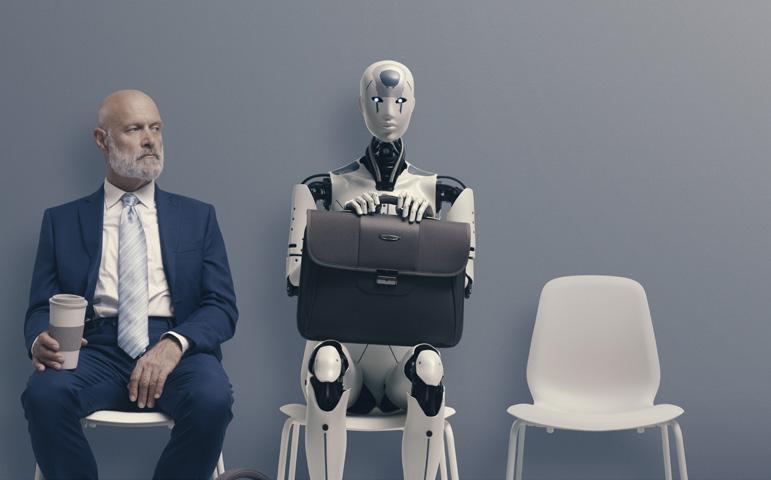
“AI won’t replace people, but people with AI [skills] will [replace them].”

deputy city manager and public safety officer for Maricopa, Arizona, predicted that like the invention of Microsoft Word, AI will change the way cities conduct hiring and do business.
result in a scaled-down workforce as the technology streamlines work previously done by humans.
On the contrary, Gaudet predicted that “AI won’t replace people, but people with AI [skills] will [replace them].” He doubled down against losing sight of the mission and prioritizing jobs over creativity and efficiency.
“Our mission is that we are here to do our job. Is our job to save jobs? Or is our job to deliver exceptional public sector services and goods to our residents in the most responsible manner?” he said. “When I wake up in the morning and go to work, I’m not going to work to try and save people’s jobs. I’m going to work to try and make the city the best it can possibly be, and I want people to come on that journey along with me.”
Gaudet advised that the key to successfully navigating the transition to AI, is getting everyone to “row in the same direction.” Like the concept of drivers’ training, alluded to in his talk’s title, he said the goal is to build confident—but not arrogant—drivers who can navigate different hazards to get from point A to point B.
“First learn stand; then learn fly,” he said, borrowing a line used in the movie “The Karate Kid” by Mr. Miyagi as he trains a young
boy to be a karate master. By this, he suggests that workers start small by slowly exploring AI applications to build confidence. Examples include experimenting with ChatGPT—a chatbot developed by OpenAI that uses large language models to enable users to refine and steer a conversation toward a desired length, format, style, level of detail and language.
Examples of entry tools include using AI to create notes following a virtual meeting. Other simple uses include employing ChatGPT to create a job description or new city policy. He suggests workers use their own preexisting domains of expertise so it’s easy to determine if the technology is providing right or wrong answers. •
View the 24th General Assembly replay at bit.ly/SBCCOGGeneralAssembly.

SECURING THE AI FRONTIER:A KEYNOTE ADDRESS
“I’ve introduced bipartisan bicameral legislation that says no matter how amazing AI ever gets, we’re never going to let it launch a nuclear weapon by itself.”
– Ted Lieu, Congress member, 36th District
UNLOCKING THE POWER OF AI: AN INTRODUCTION TO ARTIFICIAL INTELLIGENCE
“For the first time in mankind’s history on this planet, there’s a distinct possibility that AI might or will surpass human intelligence.”
– Philip de Souza, president, Aurora Systems Consulting, Inc.
AI AND CITIES: BALANCING PROGRESS AND RESPONSIBILITY
“AI isn’t going to automate everything. We can use it more as a co-pilot or sort of a responsible efficiency-boosting tool rather than something that’s just going to do our jobs for us.” – Christopher Jordan, senior specialist on urban innovation, National League of Cities
“Think of it [large language models like ChatGPT] as a cure for writer’s block.”
– Peter Peter Pirnejad, city manager, Town of Los Altos Hills
AI AND THE 2024 ELECTIONS
“The 2024 election is all about AI literacy. Voters need a basic understanding of how AI can impact their vote.” – Susan Gonzales, CEO, AIandYou
Thank you, sponsors and friends, for your generous support
24th Annual SBCCOG General Assembly
Artificial Intelligence: Friend or Foe for the South Bay?
Benefactors $5,000
Chevron Products Company
Daily Breeze | Beach Reporter | Palos Verdes Peninsula News • LA County Supervisor Holly Mitchell • South Bay Association of Realtors® (SBAOR)
Sponsors $2,500
4LEAF, Inc. • AECOM • American Dark Fiber • California State University
Dominguez Hills • Clean Power Alliance
• Continental Development Corporation
| Mar Ventures, Inc • Gannett Fleming
• Geo Search, Inc. • Kaiser Permanente
• Kosmont Companies • Los Angeles County Sanitation Districts • LA County Supervisor Janice Hahn • Metropolitan Water District of Southern California
• Microsoft • Southern California Association of Governments • Southern California Edison • Sunflower Farms Nursery • Telehealth Van • TransTech
Engineers Inc. • The Energy Coalition
• Water Replenishment District of Southern California • Watson Land Company • West Basin Municipal Water District
•
Friends of the SBCCOG
Caffe Luxxe • Cherrystone Restaurant • The Easy Reader • Gaetano’s Restaurant
• General Technology and Solutions • Giuliano’s Market Gardena • Good Stuff Restaurants • LA Skating Academy • Lomeli’s Restaurant • Pages Bookstore
• Piccini Italian Takeout • Shade Hotel
• SoCalGas • Sorrento Italian Market • South Bay Workforce Investment Board
SPECIAL THANKS
City of Carson for hosting the event.
SBCCOG Executive
Director Jacki Bacharach speaks with a Carson TV producer about how cities can benefit from General Assembly content.
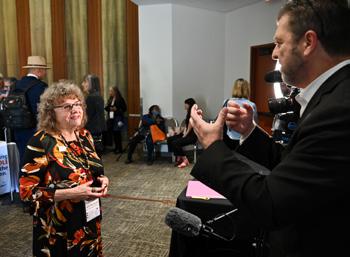
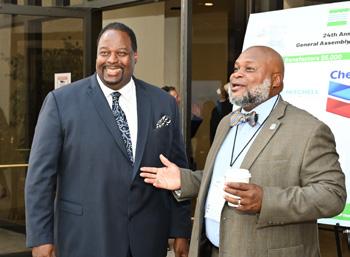
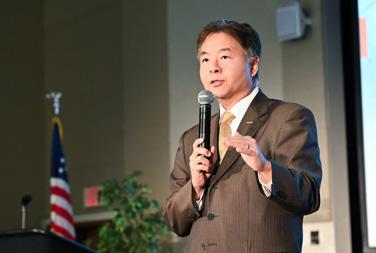
As the General Assembly’s keynote, 36th District Congress Member Ted Lieu encouraged attendees to check out AI tools for themselves to understand the capabilities of the technology.
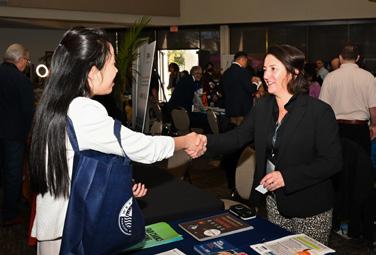
The community explored the General Assembly exhibit hall, which featured AI technology and informational displays from several dozen public agencies and companies, including tech giants Microsoft and Google.
From left: SBCCOG Board Chair and Carson Council Member Cedric Hicks Sr. chats with event emcee Gardena Council Member Mark Henderson, who was recently recognized as a Top 20 Technologist, Transformer and Trailblazer by the Center for Digital Education.
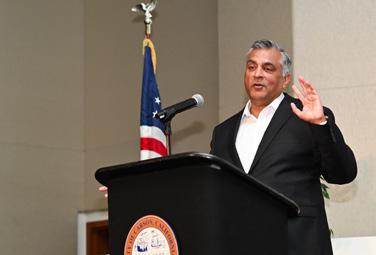
Philip de Souza, president of Torrancebased Aurora Systems Consulting, Inc., set the stage for the day’s content with his talk, “Unlocking the Power of AI: An Introduction to Artificial Intelligence.”
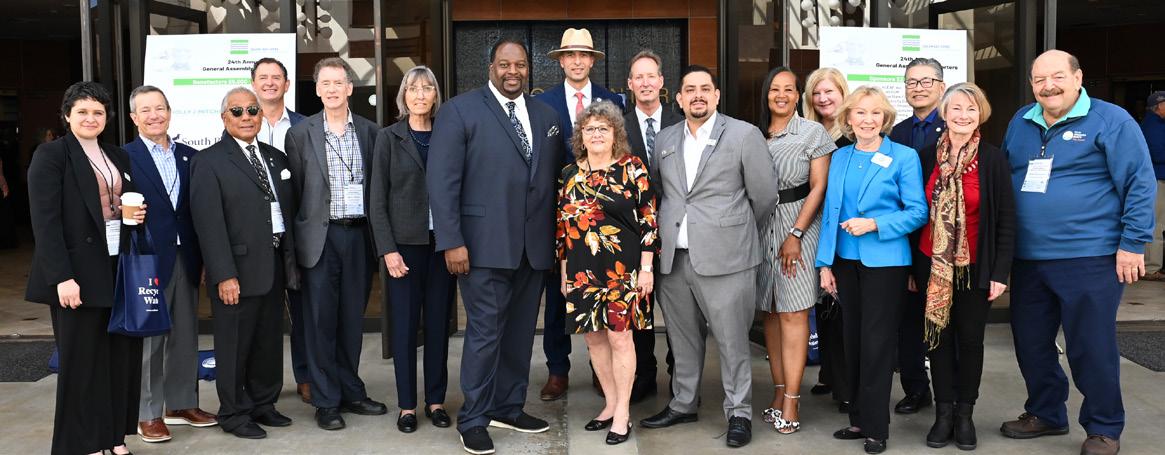
Holly
Last fall the South Bay Cities Council of Governments hosted the “Sustainability in Action Photo Contest” to celebrate the 20th anniversary of its South Bay Environmental Services program. Attendees of the 24th General Assembly were invited to select the finalists through an online vote. Among 10 finalists, two tied for first place. The winners depict children in the South Bay learning about sustainability in their backyard.
Jeffrey McBurney is a horticultural teacher at Rudecinda Sepulveda Dodson Middle School in Rancho Palos Verdes. In his winning submission, titled “Middle School Students Making Incremental Change in Their Corner of South Bay Los Angeles,” he captures his

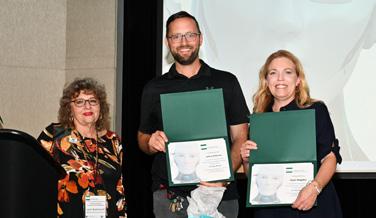
SBCCOG Executive Director Jacki Bacharach recognizes Jeff McBurney and Starr Nagdev for their first-place Sustainability in Action photo contest entries at the 24th General Assembly.
students’ hands reaching for radishes they planted and harvested from seed.
“I am excited to win because their hands are at the center of it. And they [the students] come from a variety of cities all throughout the South Bay,” McBurney said. “The South Bay is a biodiverse place from the humans right down to the microbiome in the living soil. All kids in schools can be powerful drivers of change, and this photo puts their work toward sustainability at the center.”
In the photo, McBurney’s students had just completed the planting and harvesting project as part of their first unit in his class following an upgrade to the school’s garden space. His horticulture classes are now engaged in a unit about biodiversity and ecosystem health called “The Symbiotic Schoolyard,” which he said culminates with those same hands pictured planting more than 100 native plants around the garden’s border—“giving a native plant hug to green space and supporting wildlife.”
With the second winning photo, photographer Starr Nagdev, a fourth grade
Know the Three E-Bike Classifications Before Making a Purchase
As South Bay cities continue to roll out the Local Travel Network, the SBCCOG has been supporting efforts to educate community members about various low-speed vehicle options. E-bikes are an increasingly popular mode due to the assistance of motors and the ability to configure the vehicles to carry people and cargo. Before making an e-bike purchase, it is important to understand that there are three classes of e-bikes suited for different ages, speeds and locations for riding. Get to know each to make an informed purchase. •
teacher at Silver Spur Elementary School in Rancho Palos Verdes, aimed to capture a collaborative local program inspiring blossoming scientists to enact change.
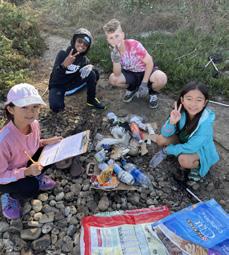
The photo depicts Silver Spur students participating in a Community in Action project hosted by the Palos Verdes Peninsula Unified School District as part of the Blue Water Task Force. Students of the project helped collect trash found at the Malaga Cove storm drain to prevent it from landing in the ocean.
The Blue Water Task Force, overseen by the Surfrider Foundation and funded by West Basin Municipal Water District, gives students the opportunity to make hands-on change. Students enter data from their collection efforts into the Surfrider portal to support citywide solutions for diverting waste from the ocean.
Nagdev hopes that the photo’s success helps to get the message out that “kids are interested in being part of this change and community partners are here to help.”
Nagdev grew up in El Segundo riding her bike across town and spending long summer days at the beach. “The beauty at our fingertips makes me want to fight to ensure that all children have this access and opportunity to be out in nature,” she said. •
View all of the finalists at southbaycities.org/photo-contest.
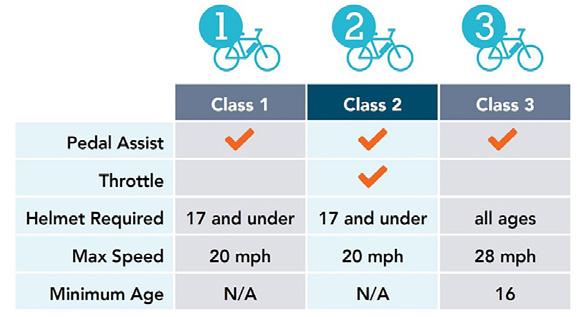
Learn more about the Local Travel Network at southbaycities.org/local-travel-network
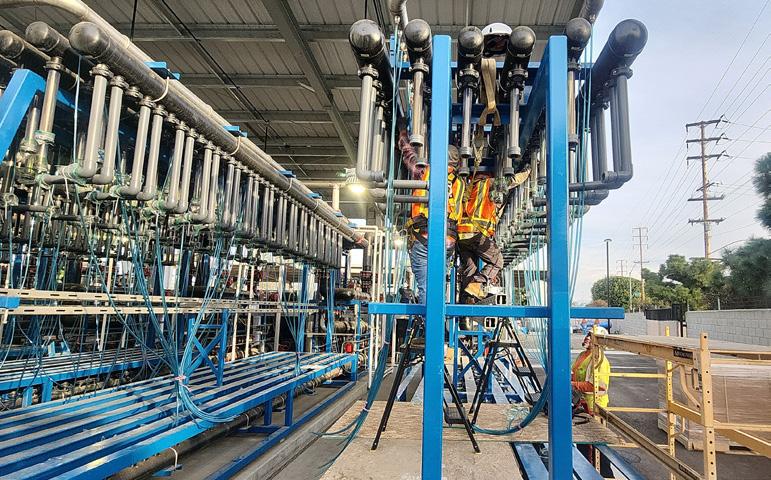
Kevin Cullen, West Basin engineer (left), and Melene Agakanian, engineer at project partner Hazen and Sawyer, stand next to West Basin’s exhibit at the “Elevating Industrial Reuse: A California Example of Water Resiliency” poster session. It was featured at the 39th Annual WateReuse Symposium.
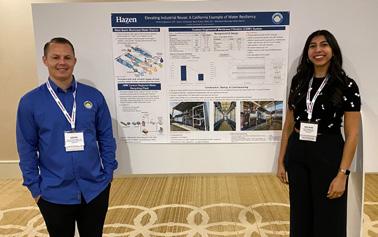
A major component of the West Basin’s Carson Water Recycling Plant expansion includes a new custom-engineered microfiltration system that will serve as water pretreatment to reverse osmosis. This allows West Basin to produce industrial boiler feed water for the neighboring Marathon oil refinery.
West Basin’s Water Recycling Plant Expansion in Carson Moves Southern California Closer to Water Self-Sufficiency
South Bay water provider West Basin Municipal Water District (West Basin) is investing in its infrastructure to maximize the use of recycled water and reduce the reliance on imported water. One example is West Basin’s recent Phase II Expansion of the Juanita Millender-McDonald Carson Regional Water Recycling Plant, which underscores this effort and ingenuity within the water industry.
The project included an expansive upgrade of its previous microfiltration system to a custom-engineered microfiltration (CEMF) system that treats nearly 6 million gallons per day. The new CEMF system greatly increases its capacity and improves the reliability of the recycled water that West Basin delivers to Marathon Petroleum’s Los Angeles Refinery (Marathon). The water recycling plant’s microfiltration system can now fit six different membrane modules, which greatly improves the water-cleaning process. This results in greater recycled water production to meet West Basin’s sustainability and reliability goals.
SEVEN KEY BENEFITS OF NEW MICROFILTRATION SYSTEM:
1. Full restoration and increase in the capacity of the reverse osmosis process—a water purification process that uses pressure to force water through a semipermeable membrane, removing contaminants and leaving behind clean water
2. Improved system maintenance, operation and water quality
3. Enhanced recycled water supply
4. Construction of new on-site backup potable (drinkable) water
connections for critical supplies
5. Installation of a backup power supply for key operating equipment
6. New ability to obtain cost-competitive pricing for future system equipment replacements
7. Installation of systems to further improve water quality
Further highlighting its impact, earlier this year in Denver, Colorado, the CEMF project was selected to be showcased at the 39th Annual WateReuse Symposium, the premier global conference on water recycling. The project exhibit at the symposium was entitled Elevating Industrial Reuse: A California Example of Water Resiliency. The project was widely and positively received by symposium attendees. For more information visit bit.ly/WaterRecyclingPlant.
West Basin also presented the project expansion at two conventions in 2023. This highlights the investments made by the district in collaboration with its partners at Marathon, the State Water Resources Control Board and Cal Water to further the message that “every drop of recycled water saves potable water for drinking and other essential uses.” •
Like many other regions across the country, Los Angeles County is being impacted by the digital divide—meaning some communities do not have equitable access, skills and support to effectively engage online. More than 325,000 (9.7%) of households in LA County do not have an internet subscription, and more than 156,000 (4.6%) of households do not have a computer. This nationwide issue was exacerbated by the COVID-19 pandemic, with various communities throughout the county disproportionately impacted by these digital inequities. This includes lowerincome households and communities that are predominantly Black, Latino, indigenous, all people of color, communities with lower educational attainment and older adults (ages 65 and up).
LA County is leading regional efforts to ensure that all communities and individuals in the region have the technology access, capacity, skills and support to fully participate in society, democracy and the 21st-century economy.
LA COUNTY INITIATIVES TO ADVANCE DIGITAL INCLUSION:
• Affordable, reliable broadband internet infrastructure deployment and services adoption
• Internet-enabled devices that meet the needs of community members
• Multilingual and culturally relevant digital literacy and skills training
• Quality hardware and software technical support
• Applications and online content designed to enable self-sufficiency, participation and collaboration
• Digital navigation support to guide community members to digital inclusion services
• Accurate, reliable and transparent broadband internet and digital equity data and maps
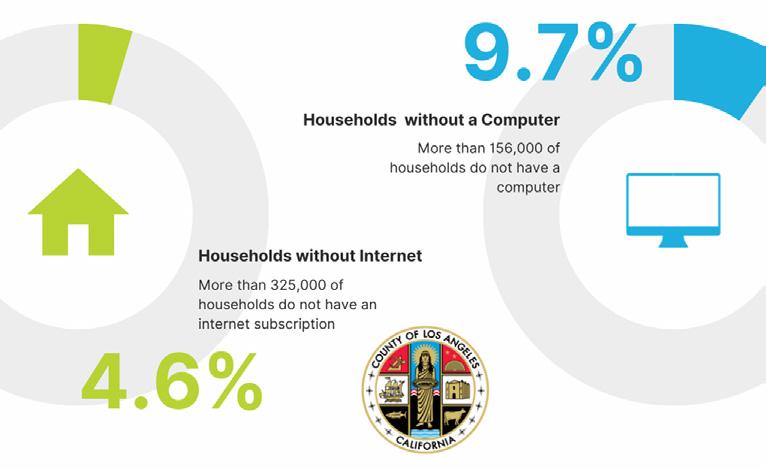
Source: bit.ly/ComputersInternetSubscriptions
The Community Broadband Networks Initiative, launched in fall 2021, is a publicprivate partnership with the county and WeLink that brings affordable and reliable broadband internet to underserved areas in East Los Angeles/Boyle Heights and South Los Angeles. WeLink offers a groundbreaking, low-cost internet plan starting at $25 per month to 50,000 qualified households in those communities. Another county initiative, Delete the Divide, implements digital equity in underserved communities through partnerships and technology resources that empower residents and small businesses. More than 200 interns are serving as digital navigators and connecting county residents to digital inclusion resources and services.
The county Intergovernmental Broadband Coordinating Committee is a regional collective body and standing committee of more than 60 multidisciplinary stakeholder organizations and community members. The committee collaborates to pursue, secure and implement federal and state grant program funding to address the digital divide across LA County through county-
led intergovernmental and cross-sector regional coordination. This includes pursuing, securing and implementing Broadband Equity, Access and Deployment and Digital Equity Act program funding opportunities that are expected to be available in 2024. With uplifting collective impact, a racial equity lens, and a shared responsibility for action in collaboration and partnership with the communities most in need, the public, private and nonprofit sectors are key to advancing digital equity in LA County. This includes co-creating, co-implementing and co-supporting inclusive digital equity practices, policies, programs and systems change efforts.
By providing equitable access to reliable, high-speed broadband internet infrastructure and services, digital skills training, technical support and digital navigation support for every individual and household, underserved communities will thrive in day-to-day activities. •
To learn more visit doingbusiness.lacounty.gov/ade
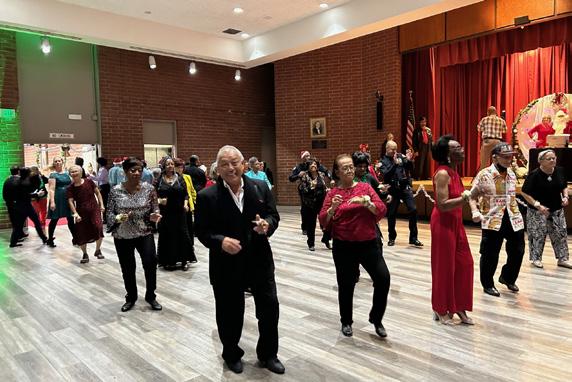
TSBCCOG’s First Vice Chair and Gardena Council Member Rodney Tanaka gets his groove on with seniors and Gardena police officers at last year’s Candlelight Dinner Gala.
South Bay Watch is a quarterly bulletin by the South Bay Cities Council of Governments to inform local leaders of subregional progress and alert them to emerging issues.
Governing Board: Chair
Cedric Hicks, Carson 1st Vice Chair
Rodney Tanaka, Gardena 2nd Vice Chair
Bernadette Suarez, Lawndale
Immediate Past Chair
John Cruikshank, Rancho Palos Verdes
Members:
Carson, Los Angeles County, El Segundo, Gardena, Hawthorne, Hermosa Beach, Inglewood, Lawndale, Lomita, Los Angeles, Manhattan Beach, Palos Verdes Estates, Rancho Palos Verdes, Redondo Beach, Rolling Hills, Rolling Hills Estates, Torrance
hree years ago, Linda Barentine, 73, of Gardena retired from her 27-year career at the Los Angeles Air Force Base in El Segundo, where she had helped airmen transition to civilian life. But after only a few weeks, she discovered she could re-deploy her experience and skills to help her new peers—seniors and retirees—transition to active lifestyles.
She spotted an ad seeking seniors to join Gardena’s Affiliated Committee On Aging. “I wanted to give back and decided to see what the committee was all about,” she said. “There is so much fellowship in Gardena’s senior programs. It’s good for the body and good for the soul.”
Her committee involvement led to her appointment to serve on Gardena’s Senior Commission. The commission steers the direction of Gardena’s Senior Citizens Bureau, a body under the city’s Human Services Division that provides services to the community to allow participants to enhance their quality of life and to maintain their independence.
The senior bureau offers Meals on Wheels, which delivers hot lunches for homebound residents. A Supportive Services program offers assistance with light housekeeping, transportation to local appointments, and guidance on paperwork and applications.
It also offers more than 100 events and activities each year, including Gardena-On-The-Go trips to various points of interest and monthly Candlelight Dinners for a modest donation at the city’s Nakaoka Community Center. The Walking Club meets weekly in the morning at Gardena’s Willows Wetland Preserve, located at Arthur Johnson Park.
At last year’s Senior Gala, participants dressed in their finest attire and were joined on the dance floor by members of the Gardena police force. “The police officers never stopped dancing—even our chief,” said Stephany Santin, director of Gardena’s Recreation and Human Services Department.
Supportive programs are also available for older adults who are frail or experiencing memory loss, dementia or Alzheimer’s disease as well as for caregivers and family members at the Gardena Senior Day Care Center at Saint John Lutheran Church. The center will soon get a new home. Under Proposition 68, Gardena received $8.5 million to build the Gardena Community Aquatic and Senior Center at 1654 W. 160th Street. Anticipated to be completed in spring 2025, it will offer a pool, public art, an outdoor gym and picnic areas.
According to Santin, the project speaks to the city’s commitment to help the full spectrum of its population to thrive. “The culture here in Gardena has always been to care for their elders,” she said. “I think it’s something that everyone is really passionate about.” •
Gardena’s senior programs are open to Gardena residents and nonresidents. To learn more, visit cityofgardena.org/seniors-citizen-bureau. Learn more about the Gardena’s Aquatic and Senior Center project at bit.ly/AquaticandSeniorCenter.
SBCCOG Executive Director
Jacki Bacharach
Legal Counsel
Michael Jenkins, Best Best & Krieger LLP Treasurer
Matthew Robinson, City Treasurer City of El Segundo
Editor
Colleen Farrell, Senior Project Manager, Communications
Contributor
Rosemary Lackow, Administrative Assistant Design
Vincent Rios Creative, Inc.
To subscribe to SBCCOG newsletters or view past editions, visit southbaycities.org/newsletter.
To view a schedule of SBCCOG meetings, visit southbaycities.org/calendar.
Website: southbaycities.org
Follow us: facebook.com/SBCCOG facebook.com/SBESC
@SouthBayCCOG @SBESC @southbayccog